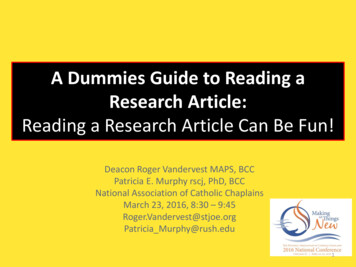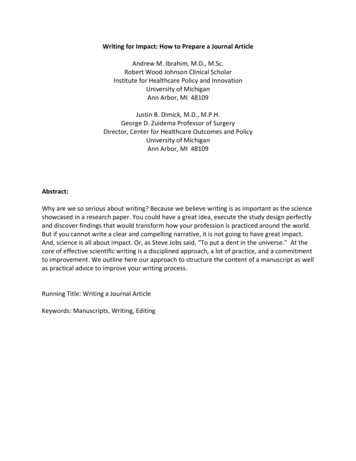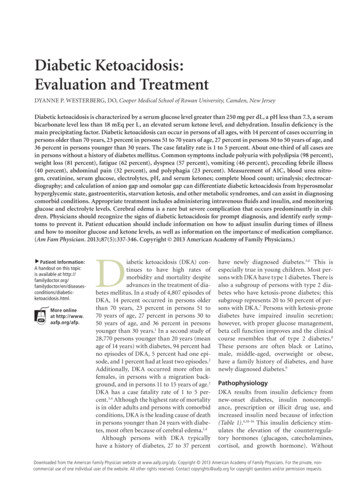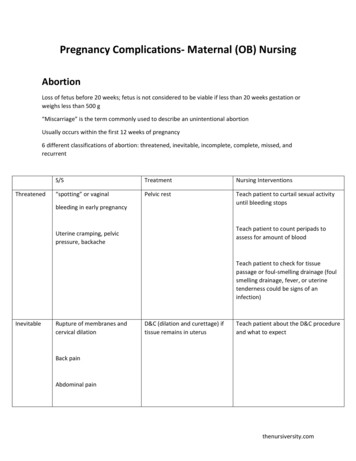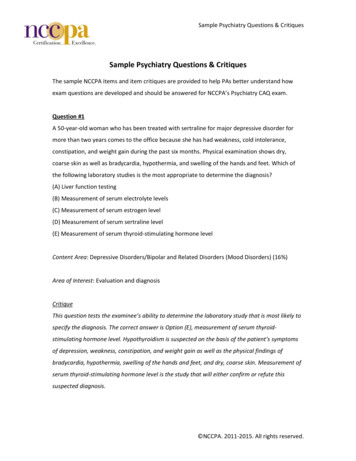
Transcription
Hindawi Publishing CorporationInternational Journal of EndocrinologyVolume 2016, Article ID 8519362, 8 h ArticleSerum Adiponectin Level as a Predictor of Subclinical Cushing’sSyndrome in Patients with Adrenal IncidentalomaAsli Dogruk Unal,1 Semra Ayturk,2 Derya Aldemir,3 and Neslihan Bascil Tutuncu41Memorial Atasehir Hospital, Department of Endocrinology and Metabolism, Istanbul, TurkeyTrakya University Hospital, Department of Endocrinology and Metabolism, Edirne, Turkey3Baskent University Hospital, Department of Biochemistry, Ankara, Turkey4Baskent University Hospital, Department of Endocrinology and Metabolism, Ankara, Turkey2Correspondence should be addressed to Asli Dogruk Unal; aslidogruk@yahoo.comReceived 21 June 2016; Revised 8 August 2016; Accepted 14 August 2016Academic Editor: Marek BolanowskiCopyright 2016 Asli Dogruk Unal et al. This is an open access article distributed under the Creative Commons AttributionLicense, which permits unrestricted use, distribution, and reproduction in any medium, provided the original work is properlycited.Subclinical Cushing’s syndrome (SCS) is a condition of slight but chronic cortisol excess in patients with adrenal incidentaloma(AI) without typical signs and symptoms of Cushing’s syndrome. Adiponectin has potent roles in modulating energy balanceand metabolic homeostasis and acts in opposition to glucocorticoids. This study aimed to evaluate adiponectin level in SCSand nonfunctional AI (NAI) patients and its relation with metabolic parameters. Patients with AI (𝑛 40) and metabolicallyhealthy controls (𝑛 30) were included. In AI patients and controls, detailed medical history assessment, physical examinations,anthropometric measurements, and laboratory measurements were performed. Age, body mass index, waist circumference, andlipid profiles were significantly higher and waist-to-hip ratio and adiponectin level were significantly lower in the AI patients thanin the controls. The midnight cortisol and urinary free cortisol levels were significantly higher in the SCS patients (𝑛 8) than inthe NAI patients (𝑛 32). Adiponectin level of the SCS group was significantly lower than those of the NAI and control groups.The sensitivity and specificity for an adiponectin level of 13.00 ng/mL in predicting the presence of SCS were 87.5% and 77.4%,respectively. In conclusion, adiponectin is valuable in predicting the presence of SCS in AI patients.1. IntroductionAdrenal incidentaloma (AI) is an adrenal mass that is typically discovered serendipitously during radiologic examinations performed for unrelated reasons [1]. AI is observed inapproximately 5% of all abdominal computed tomography(CT) scans and its prevalence in the general population hasbeen estimated as 3%–7% [2]. The prevalence of AI increaseswith age; the likelihood of encountering an AI on CT is 10%in patients aged 70 years and older [3].Most of the AIs are benign adenomas and do not exhibithyperfunction [2]. Nevertheless, pheochromocytoma, aldosteronism, or overt cortisol excess due to hyperfunction canbe observed in patients with AI [4]. Autonomous cortisol (aglucocorticoid hormone) secretion in patients with featuressimilar to Cushing’s syndrome (CS) such as obesity, hypertension, glucose intolerance, and osteoporosis but withouttypical signs or symptoms of hypercortisolism is defined assubclinical CS (SCS) [4–6]. The clinical presentation of CSvaries according to the extent and duration of cortisol hypersecretion; however, proximal muscle wasting, wide purplestriae, and easy bruising are the unique signs of CS. Specifically, patients with hypercortisolism usually present withcentral obesity, a round and erythematous face, supraclavicular fat pads, cervical fat accumulation called buffalo hump,thinning of the skin, and proximal muscle weakness [7–10]. Inpatients with SCS, slight but chronic cortisol release has beenassociated with increased cardiovascular risks and metabolicsyndrome [11, 12]. SCS diagnosis is established via abdominalCT scan in patients having an incidental adrenal mass, without the above-mentioned typical physical features of CS, andexhibiting endogenous hypercortisolism in hormonal tests.Nevertheless, there are no universally accepted hormonal criteria for SCS diagnosis [6, 13–16]. A cortisol value of 5 𝜇g/dL
2after 1-mg dexamethasone suppression test (1-mg DST) isaccepted as a sufficient criterion to diagnose SCS [15–17].Patients with cortisol values between 1.8 𝜇g/dL and 5 𝜇g/dLin this test should also have at least one other criterion:lack of circadian cortisol secretion rhythm (late evening tomorning serum cortisol % ratio exceeded 50%), decreasedmorning adrenocorticotropic hormone (ACTH) concentration ( 10 pg/mL), and/or increased 24-hour urinary freecortisol excretion [15–17].Adiponectin, a peptide with 244 amino acids, is a veryimportant hormone that is secreted primarily from white adipose tissue. Adiponectin is involved in metabolic processesand negatively correlates with obesity [18]. Glucocorticoidsand adiponectin play opposing roles in regulating energymetabolism, where glucocorticoids activate catabolic processes and insulin resistance. Adiponectin acts primarily asan insulin sensitizer [18, 19]. There is growing evidence thatadiponectin has protective effects against type 2 diabetes mellitus [20]. Additionally, with respect to immune and inflammatory processes, both glucocorticoids and adiponectin haveanti-inflammatory effects [21, 22]. Thus, there is an increasinginterest in the clinical application of adiponectin on variety of diseases such as dyslipidemia, metabolic syndrome,hypertension, and cancer (breast, colon, and prostate cancers)[23]. Drugs enhancing endogenous adiponectin productionor using recombinant adiponectin attract attention as thepotential treatment targets [24].It is known that the metabolic abnormalities of SCSremain elusive [25]. Surgical removal of autonomously cortisol-secreting adenoma has beneficial effects on blood pressure and insulin sensitivity [26, 27]; however, there are stillinsufficient data to support routine adrenalectomy in theclinical setting [28]. In a study, the patients with CS wereobserved to have low adiponectin levels; however, obesity wasreported to mask the relationship between adiponectin andcortisol [29]. The present study aimed to evaluate adiponectinlevels in patients with SCS and nonfunctional AI (NAI) andits relation with metabolic parameters.2. Materials and Methods2.1. Subjects. Patients (𝑛 40) referred to the Endocrinologyand Metabolic Disease Outpatient Clinic for incidentallydiscovered adrenal masses were included in the present study.The control group included metabolically healthy subjects(𝑛 30) without adrenal adenomas or hyperplasia. Patientswith type 1 diabetes mellitus, uncontrolled hypertension,chronic renal failure, chronic hepatic disease, depression,or alcoholism or those who were on medication that couldinfluence insulin, cortisol, and dexamethasone metabolismsor cortisol secretion were excluded from the study. All thepatients diagnosed with type 2 diabetes mellitus were newlydiagnosed patients and not on any antidiabetic treatment. Thepatients included in the present study were not using statinsfor about 12 weeks.In AI patients and controls, detailed medical historyassessment, physical examinations, and anthropometric measurements were performed. Blood samples were obtained at08:00 a.m. for the measurements of basal cortisol, ACTH,International Journal of Endocrinologydehydroepiandrosterone sulfate (DHEAS), fasting blood glucose (FBG), and insulin levels as well as lipid profiles andadiponectin levels. Additionally, 24-hour urinary cortisolexcretion and midnight cortisol level were measured and 1mg DST was performed in the SCS and NAI patients.The study was approved by the Baskent UniversityInstitutional Review Board and Ethics Committee (Projectnumber KA07/69) (Ethics Committee for Baskent UniversityHospitals) and conducted in accordance with the Declarationof Helsinki II. All participants provided written informedconsent before participating in the study.2.2. Measurements. All incidentalomas discovered by abdominal ultrasound or magnetic resonance imaging (MRI) wereevaluated by CT. On CT, all adrenal masses were homogenous, hypodense, and well shaped which were the featuresconsistent with the diagnosis of adrenocortical adenoma. Nopatient had evidence of metastatic disease. In each patient,three diameters of the adrenal mass were measured and thelargest diameter was recorded.The 24-hour urinary metanephrines and the aldosteroneto-renin ratio were within normal ranges in AI patients,thus excluding pheochromocytoma and aldosteronoma. AllAI patients with hypertension initiated verapamil 6 weeksbefore functional evaluation. None of the patients had overtsigns or symptoms of CS. The diagnosis of SCS was basedon the presence of at least one of the following in additionto cortisol levels greater than 1.8 𝜇g/dL after 1-mg DST [13]:(1) urinary free cortisol (UFC) levels of 300 𝜇g/day in twoof the three consecutive collections per 24-hour period, (2)ACTH levels of 10 pg/mL ( 2.2 pmol/L), and (3) low serumDHEAS levels.The body mass index (BMI) was calculated as weightin kilograms divided by height in meters square (kg/m2 ).The waist-to-hip ratio was calculated as the ratio betweenthe smallest circumference of the torso and the maximumcircumference of the hips over the buttocks. Body composition was measured by bioelectrical impedance analysis usingthe TANITA TBF-300 Body Composition Analyzer (TanitaCorp., Tokyo, Japan). Anthropometric measurements wereobtained using standardized equipment and following therecommendations of the International Biological Program.Serum cortisol, UFC, and DHEAS levels were determinedusing commercial radioimmunoassay (RIA) kits (Immulite2000; Diagnostic Products Corp., Los Angeles, CA, USA).ACTH levels were measured using an immunoradiometricassay (IRMA) (Immulite 2000). The 24-hour urine-fractionated metanephrines and vanillylmandelic acid (VMA) weremeasured using high-pressure liquid chromatography, inwhich the container was acidified with 10 mL to 25 mL of6 N HCl for the preservation of the metanephrines. Beforeurine collections for VMA testing, patients were asked toavoid salicylates, caffeine, tea, chocolate, bananas, and vanillafor 72 hours. Plasma aldosterone concentrations (PAC) weremeasured by RIA and quantitative determination of plasmarenin activity (PRA) was done by the enzyme-linked immunosorbent assay (ELISA). The blood sample was collected ina tube containing ethylenediaminetetraacetic acid. The lowerlimit of the assay for the detection of PRA was 0.1 ng/mL/h.
International Journal of Endocrinology2.3. Statistical Analyses. Data analyses were performed usingthe PASW Statistics for Windows, version 18.0 (SPSS Inc.,Chicago, IL, USA). Descriptive statistics were expressed asnumber and percentage for categorical variables and asmean, standard deviation, median, 25th percentile (𝑄1), 75thpercentile (𝑄3), and minimum and maximum for numericalvariables. For the comparisons of independent numericalvariables, when normal distribution assumption was not met,Mann–Whitney 𝑈 test was used for two group comparisons and Kruskal-Wallis test was used for multiple groupcomparisons. For subgroup analyses, Mann–Whitney 𝑈 testwas performed with the Bonferroni correction. Chi-squaretest was used for between-group comparisons of categoricalvariables. In order to determine the relationship betweenadiponectin level and numerical variables, Spearman’s rhotest was used when normal distribution assumption was notmet. The receiver operating characteristics (ROC) analysiswas used to determine the value of adiponectin level in predicting the presence of AI and SCS. The statistical significancewas evaluated at a type 1 error of 5%. The independent effectsof age, gender, waist circumference, hip circumference, waistto-hip ratio, body fat percentage, fat-free mass (FFM), insulin,HOMA-IR, LDL-C, HDL-C, triglyceride, and study groupvariables, which yielded a 𝑝 value of 0.200, on adiponectinwere investigated by performing multivariate linear regression analysis. Thereafter, a model including age, gender, hipcircumference, HOMA-IR, LDL-C, and study group variableswas developed. For linear regression analysis, a logarithmictransformation was performed for adiponectin levels.3. ResultsThe present study included 40 AI patients (24 females and16 males) with a mean age of 60.5 8.2 years (range, 45–76years). The control group included 30 subjects (22 femalesand 8 males) with a mean age of 26.0 4.4 years.The clinical, demographic, and metabolic characteristicsof the AI patients and controls are shown in Table 1. Age, BMI,waist circumference, and levels of total cholesterol, LDL-C,4539.440Adiponectin level (ng/mL)The cut-off value for PAC (in ng/dL)/PRA (in ng/mL/h) ratiowas accepted as 20 for hyperaldosteronism.For the measurement of FBG, an enzymatic colorimetricmethod with glucose oxidase was used. Lipid profiles, including triglycerides, high-density lipoprotein cholesterol (HDLC), and low-density lipoprotein cholesterol (LDL-C), wereassessed using commercially available assay kits (Roche Diagnostics, GmbH Roche Molecular Biochemicals, Mannheim,Germany). Insulin levels were measured using the Immulite2000 immunoassay analyzer (Euro/DPC, Llanberis, UK). TheHOMA-IR was estimated according to the following formula[30]: HOMA-IR [FBG (mmol/L) Fasting insulin level(mU/L)]/22.5.Adiponectin levels were measured in duplicate usinga commercially available ELISA kit (Linco Research, St.Charles, MO, USA). The sensitivity of the assay was 0.78 ng/mL. The intra-assay and interassay coefficients of variationwere less than 7.4% and 8.4%, ntrolFigure 1: Adiponectin levels in the study groups. SCS, subclinicalCushing’s syndrome; NAI, nonfunctional adrenal incidentaloma.HDL-C, and triglyceride were significantly higher and waistto-hip ratio and adiponectin level were significantly lower inthe AI patients than in the controls.Among the AI patients, 8 (20%) were diagnosed with SCSand the remaining patients (80%) were classified as NAI. Thehormonal profiles and the diameters of adrenal adenomas inthe SCS and NAI patients are shown in Table 2. The midnightcortisol and UFC levels were significantly higher in the SCSpatients than in the NAI patients. Of the 8 patients with SCS, 5had high midnight cortisol levels, 3 had high urinary cortisolexcretion, and 4 had low DHEAS levels. The patients withACTH levels 10 pg/mL were evaluated using pituitary MRIand no pituitary adenomas were detected.Comparison of the SCS, NAI, and control groups revealedthat age, BMI, waist circumference, insulin levels, HOMAIR, lipid profiles, and adiponectin levels were significantlydiffered among the groups (Table 3).Two group comparisons revealed that only adiponectinlevel was significantly lower in the SCS group than in theNAI group (𝑝 0.007); there was no significant differencebetween the two groups in terms of other parameters. Age(𝑝 0.001), insulin level (𝑝 0.002), and HOMA-IR (𝑝 0.003) were significantly higher and adiponectin level (𝑝 0.001) was significantly lower in the SCS group than in thecontrol group. Age (𝑝 0.001), BMI (𝑝 0.003), waistcircumference (𝑝 0.001), and the levels of total cholesterol(𝑝 0.001), LDL-C (𝑝 0.006), HDL-C (𝑝 0.010), andtriglyceride (𝑝 0.001) were significantly higher in the NAIgroup than in the control group. Insulin levels, HOMA-IR,and adiponectin levels were similar in the NAI and controlgroups. As a result, the adiponectin level of the SCS groupwas significantly lower than those of both NAI and controlgroups (Figure 1).Adiponectin level was significantly and negatively associated with insulin level, HOMA-IR, triglyceride level, FFM,and midnight cortisol level and it was significantly andpositively associated with body fat percentage and HDL-Cand ACTH levels (Table 4). The linear regression analysisconducted to determine the risk factors affecting adiponectin
4International Journal of EndocrinologyTable 1: Demographic, clinical, and metabolic characteristics of the adrenal incidentaloma patients and control subjects.GenderFemaleMaleAge, yearsBody mass index, kg/m2Waist circumference, cmWaist-to-hip ratioBody fat percentage, %Fat-free mass, kgFBG, mg/dLInsulin, 𝜇IU/mLHOMA-IRTotal cholesterol, mg/dLLDL-C, mg/dLHDL-C, mg/dLTriglycerides, mg/dLAdiponectin, ng/mLPatients with AI(𝑛 40)𝑛 (%)Control subjects(𝑛 30)𝑛 (%)𝑝24 (60.0)16 (40.0)22 (73.3)8 (26.7)0.245Median (𝑄1–𝑄3)Median (𝑄1–𝑄3)60 (55.5–65.5)29.1 (25.8–31.7)97 (90.5–104)0.90 (0.85–0.94)33.9 (24.6–41.9)48.6 (44.9–55.9)93.5 (88–110)8.8 (5.6–11.2)1.94 (1.38–2.47)219.6 (187.4–249.8)132.0 (101.0–156.0)52.0 (42.0–67.0)133.0 (102.0–189.0)15.6 (11.7–48.3)32 (24–44)25.8 (22.8–28.3)85 (83–90)0.93 (0.92–0.95)29.1 (26.0–33.0)44.8 (41.1–56.8)91 (88–97)6.6 (4.8–8.1)1.50 (1.20–1.98)173.2 (158.4–187.6)106.5 (94.0–120.0)46.0 (38.0–52.0)83.5 (66.0–118.0)39.3 (25.9–44.1) 0.0010.004 0.0010.0490.0970.1510.1470.0550.079 0.0010.0060.044 0.0010.034AI, adrenal incidentaloma; FBG, fasting blood glucose; HOMA-IR, homeostasis model assessment of insulin resistance; LDL-C, low-density lipoproteincholesterol; HDL-C, high-density lipoprotein cholesterol.Table 2: Hormonal profiles and adenoma diameters of the patients with adrenal incidentaloma.Patients with AIAdenoma diameter, cmBasal cortisol at 08:00 a.m., 𝜇g/dLMidnight cortisol, 𝜇g/dLACTH, pg/mLDHEAS, mg/dLUFC, 𝜇g/24 hPatients with SCSMedian (𝑄1–𝑄3)Patients with NAIMedian (𝑄1–𝑄3)3.05 (2.25–3.55)16.30 (13.20–24.65)9.15 (7.00–12.25)9.25 (8.60–12.00)22.10 (15.00–41.95)249 (215–366)1.85 (1.60–3.00)17.05 (12.40–21.25)5.10 (3.80–7.80)10.70 (8.55–13.00)51.65 (42.00–113.00)170 (140–220)𝑝0.1540.5540.0040.6120.0540.007AI, adrenal incidentaloma; SCS, subclinical Cushing’s syndrome; NAI, nonfunctional adrenal incidentaloma; ACTH, adrenocorticotropic hormone; DHEAS,dehydroepiandrosterone sulfate; UFC, urinary free cortisol.level in a model including age, male gender, HOMA-IR, LDLC, waist circumference, and presence of SCS revealed thatage was a significant increasing factor, whereas male gender,HOMA-IR, LDL-C, waist circumference, and presence of SCSwere significant decreasing factors (Table 5).Evaluation of the ROC analysis revealed that adiponectinlevel had a predictive value in determining the presence ofAI (area under the curve (AUC): 0.65, confidence interval(CI): 0.52–0.78, and 𝑝 0.034). The sensitivity, specificity,positive predictive value, and negative predictive value for anadiponectin level of 22.07 ng/mL in predicting the presenceof AI were 54.6%, 83.3%, 81.5%, and 59.5%, respectively(Figure 2).Evaluation of the ROC analysis also revealed thatadiponectin level had a predictive value in determiningthe presence of SCS (AUC: 0.81, CI: 0.67–0.96, and 𝑝 0.007). The sensitivity, specificity, positive predictive value,and negative predictive value for an adiponectin level of 13.00 ng/mL in predicting the presence of SCS were 87.5%,77.4%, 50.0%, and 96.0%, respectively (Figure 3).4. DiscussionHistologically, AIs are mostly adrenocortical adenomas. Ofthese cases, approximately 1.7% develop hyperfunction andthe risk is higher in the lesions greater than 3 cm [31].
International Journal of Endocrinology5Table 3: Demographic, clinical, and metabolic characteristics of the study groups.GenderFemaleMaleAge, yearsBody mass index, kg/m2Waist circumference, cmWaist-to-hip ratioBody fat percentage, %Fat-free mass, kgFBG, mg/dLInsulin, 𝜇IU/mLHOMA-IRTotal cholesterol, mg/dLLDL-C, mg/dLHDL-C, mg/dLTriglycerides, mg/dLAdiponectin, ng/mLSCS group(𝑛 8)𝑛 (%)NAI group(𝑛 32)𝑛 (%)Control group(𝑛 30)𝑛 (%)𝑝5 (62.5)3 (37.5)19 (59.4)13 (40.6)22 (73.3)8 (26.7)0.501Median (𝑄1–𝑄3)Median (𝑄1–𝑄3)Median (𝑄1–𝑄3)56.5 (51.5–64)26.8 (25.0–31.5)96 (85.5–100.5)0.91 (0.81–0.98)27.7 (21.5–35.1)49.9 (46.3–56.0)95 (84–121)13.3 (10.0–15.5)2.76 (2.07–4.17)193.2 (179.6–223.8)125.0 (108.0–134.5)42.0 (41.5–47.5)135.5 (103.5–241.0)12.0 (7.3–12.8)61 (56–66)29.4 (26.4–31.9)97.5 (91.5–104.5)0.90 (0.86–0.94)34.8 (25.8–43.6)48.4 (44.5–55.9)93.5 (88.5–107.5)7.9 (4.5–9.8)1.73 (1.01–2.08)221 (187.4–251.6)139.0 (101.0–162.0)54.0 (44.0–68.0)133.0 (102.0–165.0)24.4 (13.1–48.8)32 (24–44)25.8 (22.8–28.3)85 (83–90)0.93 (0.92–0.95)29.1 (26.0–33.0)44.8 (41.1–56.8)91 (88–97)6.6 (4.8–8.1)1.50 (1.20–1.98)173.2 (158.4–187.6)106.5 (94.0–120.0)46.0 (38.0–52.0)83.50 (66.0–118.0)39.4 (25.9–44.1) 0.0010.012 0.0020.0011.01.00.80.8SensitivitySensitivitySCS, subclinical Cushing’s syndrome; NAI, nonfunctional adrenal incidentaloma; FBG, fasting blood glucose; HOMA-IR, homeostasis model assessment ofinsulin resistance; LDL-C, low-density lipoprotein cholesterol; HDL-C, high-density lipoprotein cholesterol.0.60.60.40.40.20.20.00.00.20.40.61 specificity0.81.00.00.00.20.40.61 specificity0.81.0Figure 2: Receiver operating characteristics (ROC) curve foradiponectin level in predicting the presence of adrenal incidentaloma (AI).Figure 3: Receiver operating characteristics (ROC) curve foradiponectin level in predicting the presence of subclinical Cushing’ssyndrome (SCS).Cortisol hypersecretion is the most frequently encounteredhyperfunction and progresses subclinically in approximatelytwo-thirds of the cases [31]. In various studies, the frequency of SCS has been reported as 5%–47% in AI patientsdepending on the study protocol and diagnostic criteria [32].In the present study, in selected AI patients with benignadrenal lesions and without evidence of hyperaldosteronismor pheochromocytoma, the frequency of SCS was 20%. The
6International Journal of EndocrinologyTable 4: Relationship of adiponectin with other parameters.AgeAdenoma diameterBody mass indexFasting blood glucoseInsulinHOMA-IRTotal cholesterolLDL-CHDL-CTriglyceridesBody fat percentageFat-free massWaist circumferenceWaist-to-hip ratioBasal cortisolMidnight 020.1270.0570.001 0.0010.014 0.0010.0570.1920.3610.0250.0220.0670.015HOMA-IR, homeostasis model assessment of insulin resistance; LDLC, low-density lipoprotein cholesterol; HDL-C, high-density lipoproteincholesterol; ACTH, adrenocorticotropic hormone; UFC, urinary free cortisol; DHEAS, dehydroepiandrosterone sulfate.Table 5: Risk factors affecting the adiponectin level.ConstantAgeGenderHOMA-IRLDL-CWaist circumferenceSCS𝐵 or coefficients5.7480.012 0.708 0.229 0.005 0.019 1.009𝑝 0.0010.0660.0010.0240.0680.1140.005Adiponectin 5.748 0.012 age ( 0.229) HOMA-IR ( 0.005) LDLC ( 0,019) waist circumference ( 1,009) SCS ( 0,708) gender(male).HOMA-IR, homeostasis model assessment of insulin resistance; LDL-C,low-density lipoprotein cholesterol; SCS, subclinical Cushing’s syndrome.median adenoma diameter in the patients with SCS was3.05 cm. The midnight cortisol level (median 9.15 versus5.10 𝜇g/dL, 𝑝 0.004) and the UFC level (median 249 versus170 𝜇g/24 h, 𝑝 0.007) were significantly higher in the SCSpatients than in the NAI patients.Chronic release of glucocorticoids is associated withcardiovascular risk factors including abdominal obesity,insulin resistance, impaired glucose tolerance, diabetes mellitus, atherosclerosis, systemic hypertension, and dyslipidemia[33–37]. As these factors strongly affect morbidity andmortality, awareness of SCS is of importance. Conflictingresults regarding decreased insulin sensitivity in NAI patientscompared with SCS patients have been reported [12, 35, 38].In the present study, the HOMA-IR and insulin level of theSCS patients were significantly higher than the controls. Thelipid levels, BMI, and waist circumference were significantlyhigher in the NAI patients than in the controls. Theseparameters were also higher in the SCS group than in thecontrols; however, the difference did not reach statisticalsignificance. This finding might be resulting from the smallnumber of the patients in the SCS group. Elevated midnightcortisol concentration ( 5 𝜇g/dL) has been reported as amarker of increased cardiovascular risk in AI patients [39].In the present study, while the midnight cortisol level was5.10 𝜇g/dL in the NAI patients, it was 9.15 𝜇g/dL in the SCSpatients and the difference was statistically significant.Adipose tissue secretes a number of cytokines andbioactive compounds, which are called adipokines, leadingto metabolic alterations and cardiovascular morbidity [40].Adiponectin is an adipokine that is primarily produced byvisceral fat and circulates in the blood in different forms ofvarying molecular weights [41]. A low level of adiponectinis a common feature of obesity and is associated withinsulin resistance [42]. Adiponectin also plays an importantrole in the development of cardiovascular risk by affectingproinflammatory molecules [43]. Although there are studies investigating the association between adiponectin andglucocorticoids, the results are inconclusive due to different transcription factors, signaling cascades, and hormonesthat regulate adiponectin expression [44]. Glucocorticoidsregulate many different genes, signaling cascades, and transcription factors, some of which can regulate adiponectinexpression [45, 46]. Although increased cardiovascular riskfactors are observed in SCS patients, no standard treatmentstrategies exist. Therefore, we evaluated adiponectin levelsin SCS patients. To the best of our knowledge, this is thefirst study to evaluate adiponectin levels in the SCS patients.As we hypothesized, we found the adiponectin levels to belower in the SCS patients. The adiponectin levels of the SCSpatients (12.0 ng/mL) were significantly lower than those ofthe NAI patients (24.4 ng/mL) and controls (39.4 ng/mL). Inthe present study, adiponectin level was found to be positivelycorrelated with ACTH and HDL-C and negatively correlatedwith insulin, HOMA-IR, triglyceride, FFM, and midnightcortisol levels in all participants included in the present study.In a study, the adiponectin level was reported to be higherin the NAI patients than in the healthy controls and notrelated to the visceral obesity and it was hypothesized thatadiponectin might be produced from the adrenal gland [47].In the present study, adiponectin level was lowest in theSCS group and highest in the healthy control group, with astatistically significant difference between the SCS group andcontrols. Accordingly, we did not think that adiponectin wasoriginated from the adrenal glands. In addition, we did notfind a correlation between altered hypophysis-adrenal axisand adiponectin levels. In the study by Wallia et al. [48],adiponectin level was significantly increased with mifepristone throughout the course of treatment in the patients withCS. This finding also supports our result of low adiponectinlevel in the SCS patients.In the present study, a ROC analysis was performed todetermine the value of adiponectin in predicting the presence
International Journal of Endocrinologyof AI and SCS. Accordingly, we found that the sensitivity,specificity, positive predictive value, and negative predictivevalue for an adiponectin level of 22.07 ng/mL in predictingthe presence of AI were found as 54.6%, 83.3%, 81.5%, and59.5%, respectively. The sensitivity, specificity, positive predictive value, and negative predictive value for an adiponectinlevel of 13.00 ng/mL in predicting the presence of SCS werefound as 87.5%, 77.4%, 50.0%, and 96.0%, respectively.5. ConclusionsTo the best of our knowledge, this is the first study demonstrating low levels of adiponectin in patients with SCS. Presence of SCS should be considered in case of an adiponectinlevel of 13.00 ng/mL in AI patients. Low adiponectin levelsin SCS patients may be important in treatment decision dueto the known relation between adiponectin and cardiovascular events. In order to increase the evidences on this subject,further prospective follow-up studies with larger number ofsubjects are needed.Competing InterestsThe authors declare that there are no competing interestsregarding publication of this paper.References[1] G. Mansmann, J. Lau, E. Balk, M. Rothberg, Y. Miyachi, and S.R. Bornstein, “The clinically inapparent adrenal mass: update indiagnosis and management,” Endocrine Reviews, vol. 25, no. 2,pp. 309–340, 2004.[2] W. W. Mayo-Smith, “Current status of imaging for adrenal glandtumors,” Surgical Oncology Clinics of North America, vol. 23, no.4, pp. 847–861, 2014.[3] W. F. Young Jr., “Clinical practice. The incidentally discoveredadrenal mass,” The New England Journal of Medicine, vol. 356,no. 6, pp. 601–610, 2007.[4] M. Terzolo, A. Stigliano, I. Chiodini et al., “AME positionstatement on adrenal incidentaloma,” European Journal ofEndocrinology, vol. 164, no. 6, pp. 851–870, 2011.[5] J. Newell-Price, X. Bertagna, A. B. Grossman, and L. K. Nieman,“Cushing’s syndrome,” The Lancet, vol. 367, no. 9522, pp. 1605–1617, 2006.[6] I. Chiodini, “Diagnosis and treatment of subclinical hypercortisolism,” Journal of Clinical Endocrinology and Metabolism, vol.96, no. 5, pp. 1223–1236, 2011.[7] L. K. Nieman, “Cushing’s syndrome: update on signs, symptomsand biochemical screening,” European Journal of Endocrinology,vol. 173, no. 4, pp. M33–M38, 2015.[8] R. A. Alwani, L. W. S. Jongbloed, F. H. de Jong, A. J. van Der Lely,W. W. de Herder, and R. A. Feelders, “Differentiating betweenCushing’s disease and pseudo-Cushing’s syndrome: comparisonof four tests,” European Journal of Endocrinology, vol. 170, no. 4,pp. 477–486, 2014.[9] F. Pecori Giraldi, R. Pivonello, A. G. Ambrogio et al., “Thedexamethasone-suppressed corticotropin-releasing hormone
Research Article Serum Adiponectin Level as a Predictor of Subclinical Cushing s Syndrome in Patients with Adrenal Incidentaloma AsliDogrukUnal, 1 SemraAyturk, 2 DeryaAldemir, 3 andNeslihanBascilTutuncu 4 Memorial Atasehir Hospital, Dep




